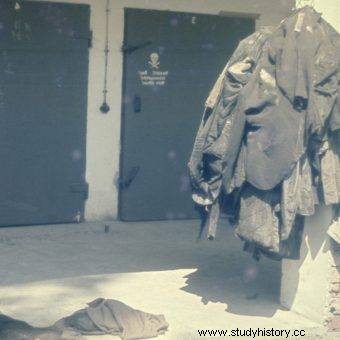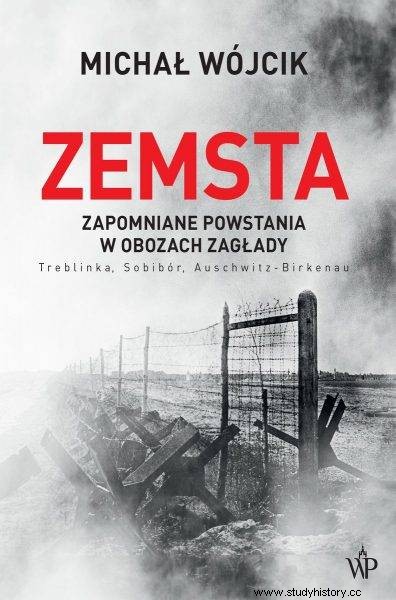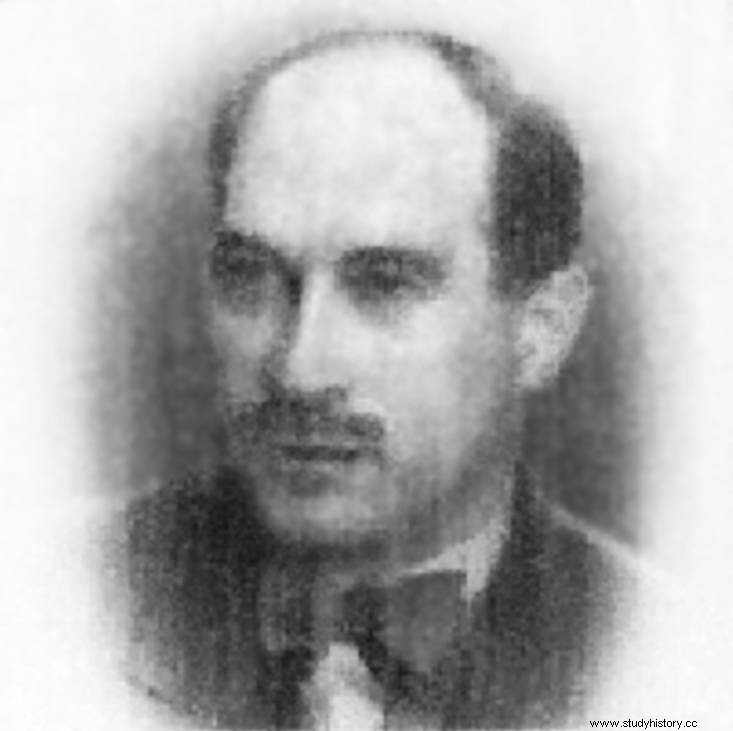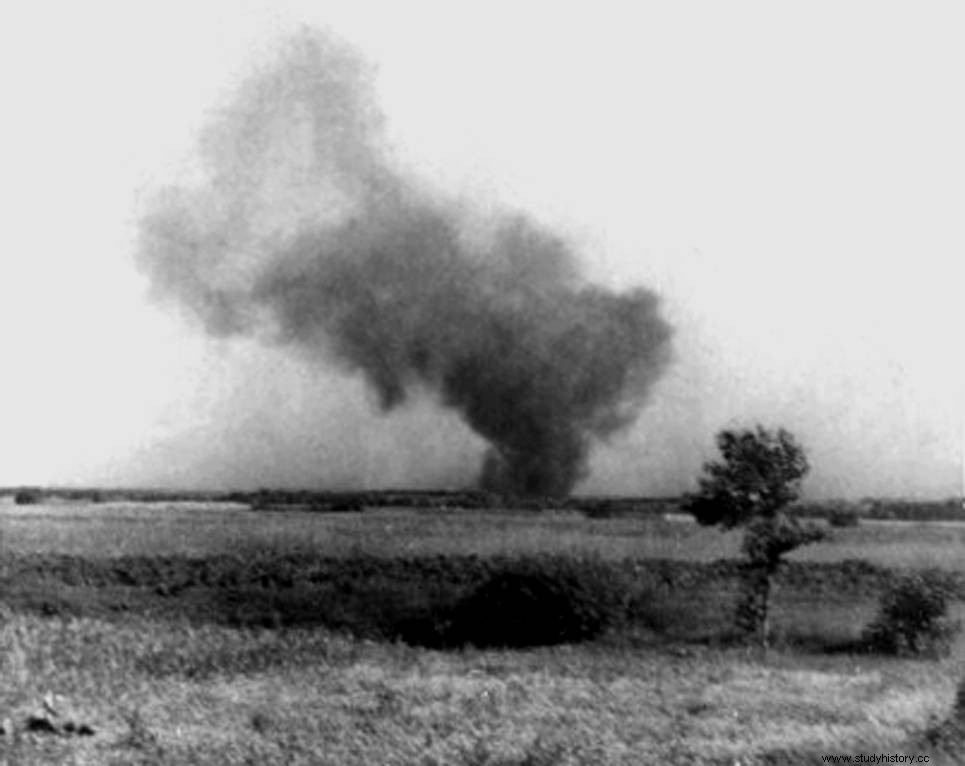The fate of the Jewish population during World War II was exceptionally tragic. The entire nation was doomed. The image of a nation reconciled with its terrible fate has been preserved in the collective memory. However, he was wrong. This is evidenced not only by the uprising in the Warsaw ghetto. Even prisoners of concentration camps had insurgent plans ...
The task of exterminating the Jews was carried out with absolute accuracy. According to the Nazi assumptions, all Jews were to disappear from Europe. The first step on this path was to isolate the Jewish population from the rest of society and confine them to ghettos. In terrible conditions, underfed and overburdened with work, they were supposed to work for the Third Reich. At the end of this road were death camps where exhausted people were massively killed.
The extermination camp system
After Poland was occupied by Germany, concentration camps were created, to which people convicted of various crimes were directed, including participation in the underground. The most famous and largest camp was Auschwitz-Birkenau.
From the conference in Wannsee in January 1942 began to implement the assumptions of the so-called the final solution of the Jewish question (Operation Reinhardt) . Transports of Jewish people from occupied Poland and from other European countries started arriving at Auschwitz-Birkenau.

Before entering the gas chamber, the prisoners were ordered to undress. They were supposed to pick up their clothes after the "shower".
Such death camps for the Jewish population were also established in Chełmno on the Ner, Bełżec, Sobibór and Treblinka. They functioned until the end of 1944, and some even until the beginning of 1945. Before the advent of the front, they were liquidated and the prisoners most often murdered.
Treatment of the Jewish population
Transports of the Jewish population that reached these camps were subject to preliminary selection. The vast majority of women, children and men unable to work were immediately sent to liquidation. Their clothes and modest belongings were taken from them, then they were cut and sent to the gas chambers. The bodies of the murdered were burned.
In some camps, e.g. in Chełmno nad Nerem, people were murdered with the use of exhaust gases introduced through a system of pipes to the sealed part of the car's body. However, it caused a lot of "troubles", because the excessive concentration of gases caused the engine to go out. This "technical problem" was solved by developing special nozzles that were… patented after the war.
The undercarriage of the car was also reworked as people who were dying put pressure on the rear wall, which made the front lift up. The German designers dealt with this by moving the rear axle by several dozen centimeters !!!

The text was created, among others based on the book by Michał Wójcik “Zemsta. Forgotten uprisings in the extermination camps:Treblinka, Sobibór, Auschwitz-Birkenau ”, which has just been published by Wydawnictwo Poznańskie. Buy now "
In other camps, Zyklon B was used for killing and the bodies were burned in the open. This was the case, for example, in Treblinka. The first transport of prisoners from the Warsaw ghetto arrived there on July 23, 1942. It consisted of 60 wagons. In the days that followed, about 5,000 Jews arrived every day. The first mass murder was the killing of Jewish workers working in the construction of the camp. One of the Treblinka prisoners recalled:
I suffered the most, looking at children with their mothers or single who did not realize that the streak of their short life would be cut off in a few minutes amid the greatest torments . Their hearts were ablaze with fear, and even more with surprise. The question "what is this and what for and why" was frozen on the child's lips. However, seeing the petrified faces of the elders, they adapt to the moment. They stand motionless or cuddle to one another or to their parents, waiting in the tension of the menacing end.
The Jews were not a "passive mass"
There is a fairly widespread belief that the Jewish population was reconciled to their fate and passively surrendered to it. However, this is a great simplification. It is true that the possibilities of resistance were small, if not to say none. Any objection was immediately liquidated and the "perpetrators" were murdered.
However, people locked in ghettos formed underground associations and sought contact with the underground on the other side of the wall. While defending themselves against liquidation, they organized resistance, although they were aware that without outside help it was doomed to failure.
However, the possibilities of supporting these activities by the underground operating in the occupied country were quite limited. In occupied Poland, helping Jews was punishable by the death penalty - not only of the person found to be the main culprit, but also of her family. Also, not everyone was convinced that such assistance should be provided.
Jewish uprisings
The most famous example of resistance and struggle with German torturers is, of course, the Warsaw Ghetto Uprising. The conspiracy, however, was created even in places where the conditions for such activity were completely absent:in extermination camps.
One of such camps was Treblinka. Most of the people who came here did not have such a chance. She was sent to death immediately after leaving the transport. The few selected for work could survive. Their longer stay in the camp provided opportunities for action. They watched what was happening with the newcomers on a daily basis and were aware that their fate would be similar.
First, attempts were made to organize escapes, which theoretically was not too difficult, because the guards on the watch did not pay much attention to their "work". However, the mere escape from the camp did not give any chance of survival. You had to find kind people who could help. However, any possible support was not always disinterested. In addition, anger and a desire to retaliate against the oppressors grew among the prisoners. After all, some of them looked at the tragic fate of their relatives, and sometimes participated in this tragedy, leading them to the chambers, and then taking their bodies out.
A group of prisoners organized in Treblinka not only planned an escape. She wanted to trigger the uprising and burn down the camp, in order to take revenge on the guards for the harm suffered . They were desperate and ready for anything. As one of the conspirators said:"It doesn't matter if we stay alive afterwards."
Julian Chorążycki was the leader of this group. However, for the idea to be realized, it was necessary to initiate the plans of those prisoners who had the opportunity to collect weapons. For this purpose, the conspirators secretly collected money and valuables from the luggage of the imported prisoners. It was planned to bribe some of the guards for them and thus obtain pistols or grenades. The removal of weapons from the camp warehouse was also perfectly planned. It became possible because one of the prisoners, Eugeniusz Turowski, managed to copy the key to the door of the weapons warehouse, next to the guards who were unaware of this fact.

Julian Chorążycki, the first leader of the underground in Treblinka
The most important people in the underground were prisoners with military training. Among them were officers brought from the Czech Republic, as well as Polish soldiers. They could not only handle weapons, but also precisely plan the entire action.
The most important element was keeping the preparations absolutely secret, which was not easy. There were many people in the camp who were ready to flatter the Germans by betraying the conspirators. There were also a few mishaps. In April 1943, the main organizer of the plot, Dr. Chorążycki, was tortured and killed by the guards, because a large sum of money was found with him, intended for bribing the Germans. The plan seemed to fail. The conspirators, however, continued.
The transports from the Warsaw ghetto after the fall of the uprising were a huge shock to the prisoners. For some it was depressing. It inspired others to resist it, as it proved that it was possible to fight the Germans. Information about the uprising was provided by three women, its participants, brought to Treblinka. As the prisoners recalled:
talked about fighting with passion. That they were proud of themselves. Despite their extreme exhaustion, they were filled with joy. (...) The Jewish uprising warmed us, poured into our veins power and new decisions. We settled down, we also wanted to act, not to let ourselves be led to death.
Rebellion in Treblinka
The insurgents wanted to take over the camp, eliminate the guards, and then burn the buildings. Despite the tension, the date of the outbreak of the uprising was postponed. On the originally scheduled day, the grenades were removed from the warehouse. Knives, crowbars and axes were prepared in the camp workshops. However, the rebels were interrupted by another transport of prisoners. Risking his life, it was therefore necessary to bring the box with grenades back to the warehouse so that the guards would not notice the lack.
In the summer, the Germans began to eliminate the traces of the crimes. The bodies of the dead were taken from mass graves and burned. At that time, the conspirators began documenting the atrocities committed in Treblinka in order to tell the world about them.
That day finally came - August 2, 1943. The conspirators entered the weapons warehouse again and took out one heavy machine gun, 20 rifles and grenades from there. Then they distributed the weapons to designated persons. We also managed to remove the weapons from the warehouse of Ukrainian guards. In the camp's tool shop, they distributed knives, axes and hammers.
The entire action was planned in detail, individual groups were assigned specific tasks. The nervous atmosphere in anticipation of the outbreak of the uprising affected all the conspirators. The beginning of the rebellion was ahead of time, although not all elements of the plan were implemented. One of the guards discovered hidden gold in the prisoner.
The insurgents joined the action. The fuel warehouse was blown up. There was a fight in the camp, the Jews captured the main watchtower. Prisoners shouted that a revolution had broken out in Berlin - which was to confuse the Germans. Several Ukrainian guards were killed, some of them returned their weapons themselves. The surprise was complete.
Subcamp II was captured and quickly fortified with a machine gun. However, the conspirators did not just want to escape from the camp - they wanted to destroy this "death factory" so that it would never play that role again. Gas chambers and camp barracks were set on fire. The command over the fight was taken over by the reserve officers, but the actions were already showing some disorganization. Hated guards and informers from among the prisoners were killed. Even an armored car was captured and used to fight against the camp crew. The captured arsenal allowed to arm another 200 insurgents.

The extermination camp in Treblinka set on fire by rebel prisoners; photo secretly taken by Franciszek Ząbecki
Czech Rudolf Masarek fired a heavy machine gun at the buildings for the guards. Unfortunately, the insurgents quickly ran out of ammunition, so they started to flee. Several hundred prisoners died in the course of the unequal fight. About 400 escaped from the camp. 105 remained on the spot. The camp was burnt down - in this sense, the short-lived uprising was a success. However, it was not possible to eliminate the crew and they quickly started chasing the escapees. Many insurgents were captured or killed. About 90 people, including eight women, survived the uprising and the escape. Thanks to them, the knowledge about the tragedy of Treblinka, as well as the heroism of the insurgents survived.
After the liquidation of the uprising, the camp continued to function for some time, as the insurgents did not manage to destroy the gas chambers. Eventually, it was liquidated, the buildings were demolished and the prisoners were killed. A farm was organized on its premises. The scale of the crimes committed was unimaginable. During the operation of the Treblinka camp, about 800,000 people were murdered and burned here.
